Note: This website was automatically translated, so some terms or nuances may not be completely accurate.
TOPPAN Global Purpose Implementation Strategy. What is the "Culture" we've made visible by engaging the world?

Sato Keiichi
TOPPAN Holdings Co., Ltd.

Shingo Watanabe
TOPPAN Holdings Co., Ltd.

Kōhei Morimoto
Dentsu Inc.

Eguchi Rumi
Dentsu Inc.
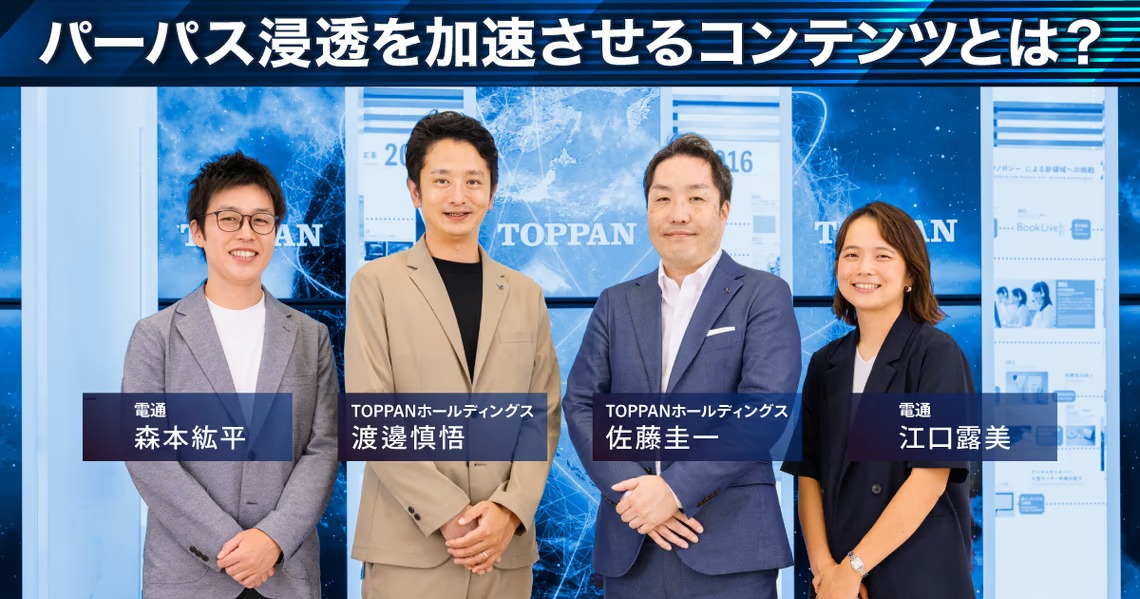
TOPPAN Holdings Inc. launched the group purpose special site " TOPPAN's Purpose Special Site " on April 1, 2025. This site features a video communicating the TOPPAN Group's purpose globally and content created with the involvement of over 125 global employees to commemorate the company's 125th anniversary.
Why did TOPPAN choose to tackle global purpose permeation centered on "content" when many companies face challenges in this area?
Keichi Sato, General Manager of the Advertising Department, Public Relations Division, TOPPAN Holdings, and Shingo Watanabe, Section Manager of the Advertising Department, along with Dentsu Inc.'s Kohei Morimoto and Rumi Eguchi, who supported this project, discuss the reasons.
For 250 companies worldwide to align in the same direction. TOPPAN's first step in purpose permeation
Morimoto: First, could you share the background behind initiating this purpose permeation initiative?
Sato: The catalyst was our transition to a holding company structure and name change in October 2023. As we rebuilt the TOPPAN brand, recognizing that "Toppan Printing is no longer just a printing company," we removed the word "Printing" from our name. Simultaneously, we shifted our focus to deepening collaboration among group companies and accelerating the pace of creating new value.
However, each group company had its own unique philosophy, vision, and other principles, and their conceptual frameworks and terminology differed. While unification would ideally be the goal, each company possesses its own distinct character and history. Within this context, we felt a need for a "group philosophy" that could serve as a common guiding principle while preserving each company's unique philosophy. This led us to the idea of establishing a purpose that clearly articulates our corporate raison d'être from a societal perspective.
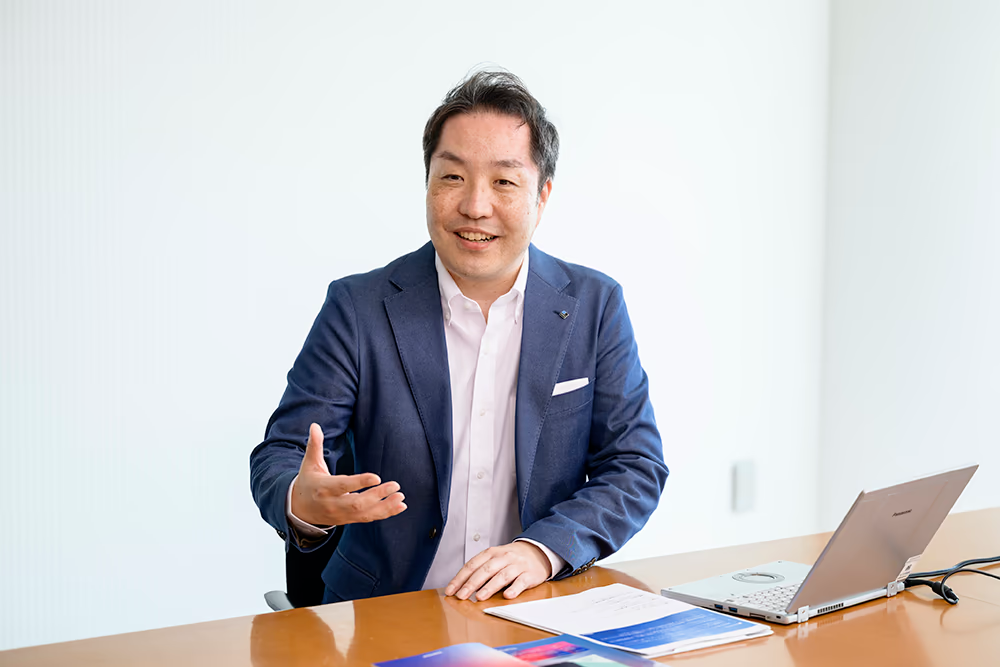
Eguchi: What process led to the formulation of that purpose?
Sato: We began around summer 2022 and spent about ten months conducting thorough research. We started with desk research, followed by interviews with management at each group company, discussions with young employees who will lead the next generation, and a questionnaire survey of all group employees. Furthermore, we utilized brand surveys targeting the general public, future forecasting materials, and third-party evaluation data to collect and analyze data from multiple angles.
We integrated these insights to organize and systematize key elements: how to meet the needs of future society, what value to provide to society, and what defines our identity and strengths. This solidified the core structure of our purpose.
We also formulated Values, articulating the shared principles employees should uphold to realize this purpose. This culminated in the completion of "TOPPAN's Purpose & Values" in May 2023.
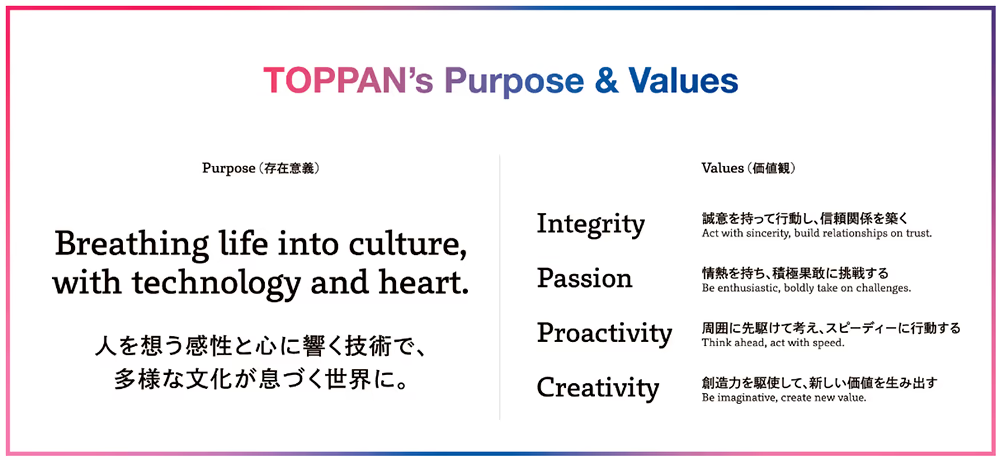
Morimoto: I hear many companies struggle to embed their purpose effectively, even after formulating it. How did your company proceed with implementation?
Sato: First, we created foundational materials to effectively communicate the Purpose and Values, including a Purpose Book, a video, portable cards, and posters. We then disseminated this information internally through various channels: online briefings, internal communication media like the company newsletter and portal site, integration into training programs, and incorporation into internal systems.
We distributed these materials, including books and posters, in multiple languages—including English and Chinese—to our overseas group companies. We also included the purpose in the textbook for new employees, enabling shared awareness from the moment they join. Furthermore, we created a special edition of our internal newsletter featuring the story behind its formulation, results from employee interviews, and dialogues with university professors.
Eguchi: It's clear you've put significant effort into ensuring its permeation. Did you also communicate it externally?
Sato: Yes. Timed with the company name change, we ran newspaper ads in 54 publications nationwide, including regional papers. We also introduced the Purpose & Values on our corporate website and a dedicated landing page. The Purpose is prominently featured in all corporate communication tools, such as company brochures, integrated reports, and sustainability reports.
Morimoto: After these efforts, did you see a change in employee reactions?
Sato: An internal survey conducted in January 2025 showed that within Japan, 98.1% of employees recognized the Purpose, and 74.6% resonated with it. Frankly, the numbers were surprisingly high, and we believe we achieved significant results in the "communication" phase.
However, significant challenges remained overseas. While we distributed posters and materials to each location, we couldn't be sure they were being properly viewed, and awareness levels varied significantly between locations.
Eguchi: So, as the next step, you began considering initiatives for the global audience.
Sato: Yes. Domestically, we needed to move from "knowing" to "personalizing," while internationally, we first needed to firmly establish the "getting known" stage. So, drawing on the example of Dentsu Inc., a global corporate group that had already pioneered various initiatives ahead of us, and with the cooperation of Mr. Morimoto and Mr. Eguchi, we decided to launch a dedicated global website.
Morimoto: We also shared insights from organizing conventions involving our domestic and international group companies. Ultimately, while keeping in mind the goal of creating such active discussion platforms, we decided to start with the preliminary "awareness-building" phase Mr. Sato mentioned.
Envisioning a world where the diverse "Culture" created by the TOPPAN Group thrives
Morimoto: While this is an internal initiative, we deliberately chose to create a dedicated site accessible externally rather than using the intranet. Could you reiterate the purpose behind this?
Sato: Looking across the entire TOPPAN Group , the intranet environments varied significantly between companies. Some regions, like China, had access restrictions, and the underlying infrastructure differed. Many companies were also acquired, and unifying their IT environments would have taken considerable time.
Therefore, we decided to create an open website accessible to all stakeholders. While the primary audience remains group employees, we designed it so external visitors wouldn't feel out of place. The content leans internal, but we concluded that the key messages should also be shared externally.
Eguchi: External communication also fuels motivation internally, right? I've worked with Morimoto-san on various internal branding and purpose-embedding initiatives from different angles, and I feel this external-internal circulation is a crucial point. Could you explain the content for this project?
Sato: The content has three main pillars. The first is a new purpose movie titled "Culture," designed to resonate globally. While we had an explanatory movie created during the purpose formulation phase, this time we aimed for a more emotional, culturally focused composition. We carefully crafted the visual tone and music to create a piece that boosts employee motivation.
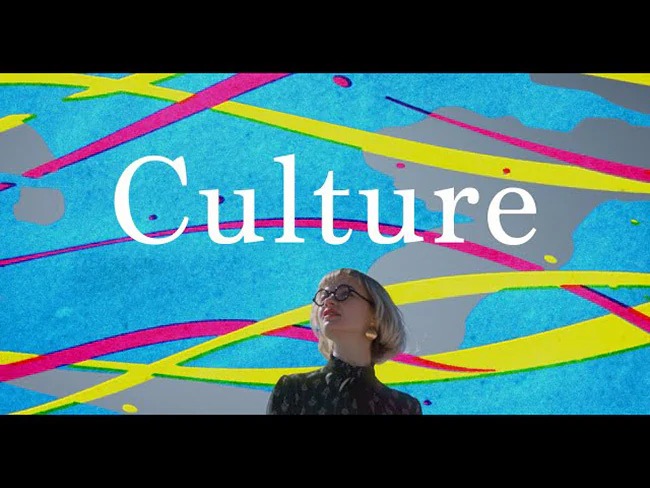
The second is interview videos with 10 individuals from both management and frontline roles. Emphasizing diversity, we featured various key personnel, both domestic and international, speaking about the Culture they are creating.

And third, messages from 125 employees. To coincide with our 125th anniversary, we gathered 125 messages from around the world titled "The Culture I Create." We intentionally increased the overseas representation and ensured a diverse mix of nationalities, ages, and job roles.
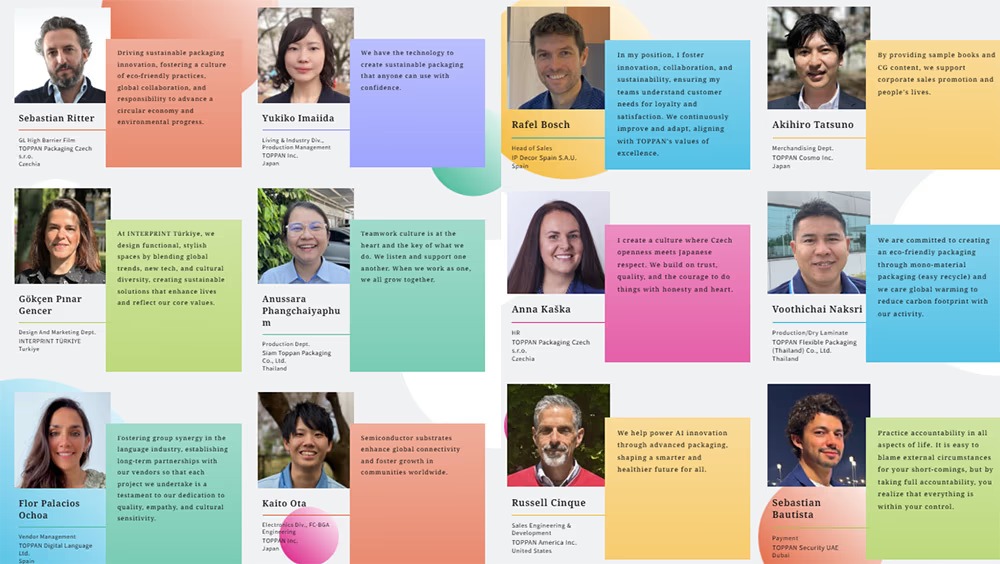
Morimoto: Eguchi-san, you provided extensive insights from your experience creating content that gathered employee voices during your time in HR at Dentsu Inc. How did you feel about this project during the conceptual stage?
Eguchi: I've done similar work before, but the employees appearing in this had their own day jobs and varied circumstances. I felt careful consideration, scheduling buffers, and a concept that boosted employee motivation were crucial. Plus, this was a global initiative on this scale. I got the strong impression TOPPAN was truly serious about this initiative.
Sato: Thank you. For the video production, we gathered department heads and executive officers for a workshop to reflect on the culture our businesses create. We spent half a day organizing the words and stories that emerged, ultimately distilling them into eight themes. Each of these cultural elements was reflected in the video's structure. It became a process where everyone reaffirmed that the seeds of culture exist within our diverse businesses—education, healthcare, security, electronic components, and more.
Watanabe: For the site's overall messaging, we changed the subject from "TOPPAN" to "we" and "I." This shift made the employees' words feel more authentic. We consciously designed the site structure to naturally evoke empathy, making visitors think, "Maybe I'm helping create this culture too."
Morimoto: It was truly moving to see each employee expressing themselves in their own words.
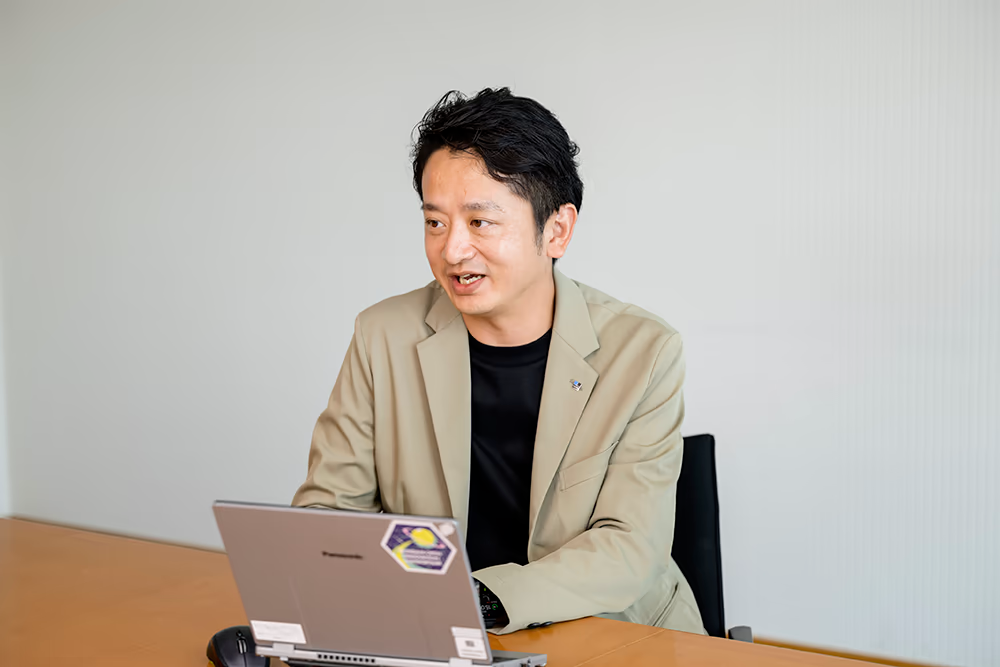
Sato: Exactly. What we prioritized this time was how to approach the question itself: how do we share our purpose? I'm sensitive to whether the term "infiltration" might sound top-down, so I try to use "sharing" instead. Rather than forcibly imposing the purpose from above, we first aim for awareness. This awareness then becomes a catalyst for individuals to reflect on their own "personal purpose." Ideally, even if only 20-30% of the company's purpose overlaps with their personal purpose, that's valuable. Conversely, the areas where they don't align can become the driving force for individuals to take initiative and move the company forward. We believe this leads to diversity within the culture and fosters innovation.
Behind the scenes of content creation: supported by meticulous work and careful communication
Morimoto: For this initiative targeting our global audience, I imagine particular care was taken in creating materials and managing the process to ensure deep understanding of the project's intent and content among colleagues in each country. How did that aspect go?
Watanabe: Yes, absolutely. The fundamental challenge was the extremely demanding schedule of traveling to five countries in a short period while simultaneously producing content. The biggest hurdle, especially for video production and collecting employee messages designed for multilingual distribution, was adjusting for language, cultural differences, and nuances in expression.
We created very detailed manuals and guidelines, and paid close attention to the tone of emails. Having Mr. Morimoto and Mr. Eguchi work hands-on with us every day, and being able to discuss repeatedly how to improve things, was very beneficial.
Morimoto: Not at all. Your dedication and passion were evident in how you interacted with local collaborators and production members.
Eguchi: Every heartfelt step taken by everyone in the Advertising Department, including Mr. Sato and Mr. Watanabe, contributed to this content, didn't it?
Watanabe: Thank you. Since this content was intended for the entire TOPPAN Group worldwide, I wanted to approach it without compromise. With Dentsu Inc.'s support, we prepared materials and interview sheets, striving to understand the interviewees' backgrounds as thoroughly as possible before conducting interviews and filming. We didn't have time for location scouting, so we had the local team share shooting sheets in advance to plan angles. I feel that each of these meticulous preparations ultimately built trust on location.
Morimoto: During the interview video shoot, when we briefed the participants on the day's schedule, I was impressed by how deeply they already understood everything beforehand. I felt that was thanks to Watanabe and the team's meticulous groundwork and information sharing.
Watanabe: Not at all. We were helped by the progress of everyone involved in the shoot, including Dentsu Inc.
Sato: I was initially worried that gathering messages might make people think, "Why go through all this trouble...?" But surprisingly, many were very positive and cooperative. In fact, we got so many requests to participate that we exceeded our target of 125 people, which was really encouraging.
A Circle of Purpose Infiltration Expanding from the Content
Morimoto: When the special site and content took shape, what were your impressions?
Watanabe: The completed interview videos were a major undertaking—10 people × 3 languages (Japanese, English, Chinese) totaling about 30 videos. But I feel we successfully visualized what makes TOPPAN unique. Beyond the content, the 125 messages themselves—even just the photos—had real impact, resulting in a truly unique final product.
Eguchi: Even if you're not featured yourself, seeing colleagues appear naturally sparks conversations or creates opportunities to watch together. Starting with these 125 individuals spread across the globe, I believe it has definitely ripple-effected to many people around them.
Watanabe: The social media response has been excellent too. It wasn't just shared internally; overseas employees voluntarily posted it on LinkedIn or shared it on Facebook. It made me realize there are ways it can spread organically, even without PR outreach.
Eguchi: This project also made me realize anew just how diverse the people within the TOPPAN Group truly are. The visual impact of conveying that diversity instantly was greater than I could have imagined.
Watanabe: While sharing a purpose across a diverse group of over 50,000 employees might seem challenging, this initiative actually made visible how that very diversity is our strength. The structure—communicating our worldview through the purpose movie, showing concrete examples via interview videos, and expressing unity and diversity through 125 individual messages—proved highly effective.
Eguchi: I thought answering the question "What kind of culture do you create?" might be difficult, but everyone approached it with genuine sincerity. It was striking how words like 'challenge,' 'unconventional mindset,' and 'integrity' – concepts aligned with TOPPAN's purpose and values – emerged naturally. Ultimately, it felt like 125 distinct expressions of "what makes TOPPAN unique" came to light.
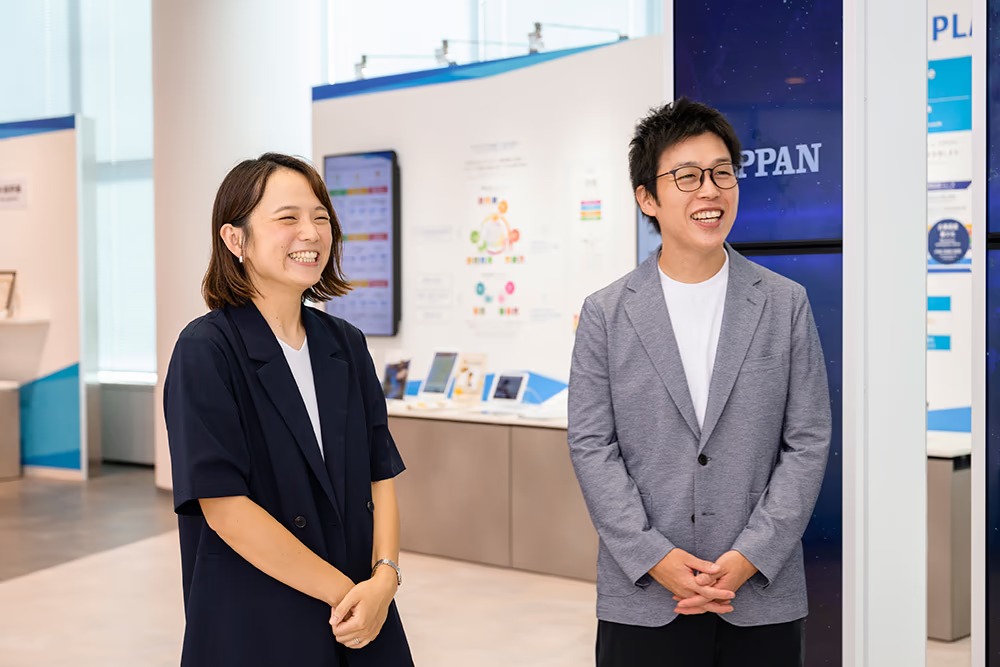
Watanabe: As Ms. Eguchi mentioned, we could also sense elements like integrity, passion, and proactivity—key TOPPAN values—in these messages. It was fascinating how naturally they came through.
Morimoto: These days, even for new hires, it seems important not just to know "what values this company holds dear," but also "what kind of people work here and what motivates them." That's precisely why I think it was so meaningful to provide employees with an opportunity to articulate their own purpose.
Watanabe: You don't often have conversations internally like, "What kind of culture are you creating?" In that sense, making visible the existence of people both domestically and internationally who approach their work with diverse motivations is an asset we can leverage for future PR activities.
Morimoto: Even if it sounds idealistic, turning it into a concrete project makes it easier to discuss and respond to. How was the reaction from inside and outside the company?
Watanabe: Some group companies even took the initiative to feature the employees who appeared in the 125 messages in their internal newsletters for deeper coverage. It seems this interview series sparked a broader internal discussion about purpose. Seeing these small ripples forming in different places makes me truly glad we did this.
Morimoto: It's wonderful that it's becoming a catalyst for communication across each company.
Watanabe: I think the key factor was definitely putting forward a question like "What Culture Are You Creating?" It's simple, yet it gets to the heart of the matter, making it a question we can use for a long time to come. Furthermore, Mr. Morimoto served as an interviewer for the domestic participants, and Mr. Eguchi for the Chinese participants. Beyond setting the right atmosphere, you both drew out so many wonderful stories. Thank you so much.
Morimoto: Not at all. Serving as an interviewer while hearing everyone's stories was a valuable experience. Both the 10 interviews and the 125 messages conveyed the participants' passion and pride in their work, which was truly inspiring for us too.
Eguchi: I similarly realized anew how TOPPAN Group's Culture is shaped by its broad business domains and diverse talent. I made many discoveries, like "This work is also done by TOPPAN!" and "Their reach extends even into this field!" It was truly rewarding to spend these intense months working alongside everyone.
Discussing the culture we are creating. That's the kind of culture we want to build.
Morimoto: Through this initiative, is there anything you'd like to try further in the future?
Sato: There are many compelling employees who didn't appear this time, so we don't want to stop at 125 people. We aim to continuously release new content going forward. I believe continuously expanding our content is key to keeping our purpose fresh and maintaining the image of "TOPPAN is this kind of company."
Watanabe: While creating empathy and sparking interest was our goal this time, the next theme is how to translate that into action. We shouldn't see this initiative as the finish line, but as the starting point, and we want to keep evolving it.
Morimoto: Finally, could you both share what kind of culture you want to build at TOPPAN going forward?
Watanabe: I hope we can naturally foster conversations like, "What kind of culture are you building?" This project revealed the foundation for such discussions. When people can proudly discuss the culture they're creating together, it's proof that our purpose is truly shared.
Morimoto: Everyone who collaborated with us this time truly spoke with pride, didn't they?
Watanabe: Yes, I did. I felt that strongly during the on-site interviews too. Experiencing that firsthand was significant.
Morimoto: Now, Sato, please.
Sato: I've long been involved in branding support for various companies. Ultimately, I believe building a brand means "building a culture." The role of PR and advertising is to visualize that culture and communicate it both internally and externally.
Throughout its long history, TOPPAN has been deeply rooted in the strong image of being a "printing company." While that solid foundation is a strength, it could also sometimes be perceived as conservative or reactive. That's precisely why, now, every single employee is moving proactively, driven by passion, aiming for "a world where diverse cultures thrive." We want to build a Culture we can be proud of, while communicating this very image.
The information published at this time is as follows.
Was this article helpful?
Newsletter registration is here
We select and publish important news every day
For inquiries about this article
Author

Sato Keiichi
TOPPAN Holdings Co., Ltd.
Corporate Communications Division
Head of Advertising / Branding Director
After working in sales at an advertising agency, joined Toppan Printing Co., Ltd. in 2006. Since then, has been involved in numerous branding projects within the brand consulting division. Transferred to the corporate communications department in 2017 and assumed current position in 2021.He is driving TOPPAN's rebranding initiative. He serves as a standing director of the Japan Marketing Association and a director of the Japan Public Relations Association. He has given numerous lectures on branding, public relations, and advertising. His book, "The Inevitable Choice: How Anyone Can Start 'Branding'" (Kodansha), is available.

Shingo Watanabe
TOPPAN Holdings Co., Ltd.
Corporate Communications Division
Public Relations Department Manager
After joining TOPPAN, he worked in the planning and production department, handling numerous client promotional media productions and directing photo shoots. After cultivating his creative and customer perspectives, he joined the Public Relations Division in 2020. He is currently engaged in TOPPAN's corporate rebranding. Former JICA Japan Overseas Cooperation Volunteers (dispatched to Vietnam).

Kōhei Morimoto
Dentsu Inc.
Marketing Division 8
Content Producer
Focusing on solving management challenges through "content that moves the heart." Launched the "Company Song Contest" in 2016. Numerous initiatives leveraging unique connections with small and medium-sized business owners. Also responsible for project development centered around IP, major corporate purpose initiatives, and startup ventures. Former Koshien baseball player (Captain of Chiben Wakayama High School / Vice-Captain of Keio University).

Eguchi Rumi
Dentsu Inc.
Marketing Division 8
Content Planner
After working in recruitment communications strategy and talent scouting for creators at the HR department, I transitioned to corporate strategic planning. I currently lead numerous projects centered on "content that enriches lives," including promotional planning for the film "10 Years to Live," producing the corporate entertainment platform "Company Anthem Contest," implementing purpose-driven initiatives for global corporations, and developing new advertising media. My hobby is mountain climbing. I summited Kilimanjaro, Africa's highest peak, in 2020.

